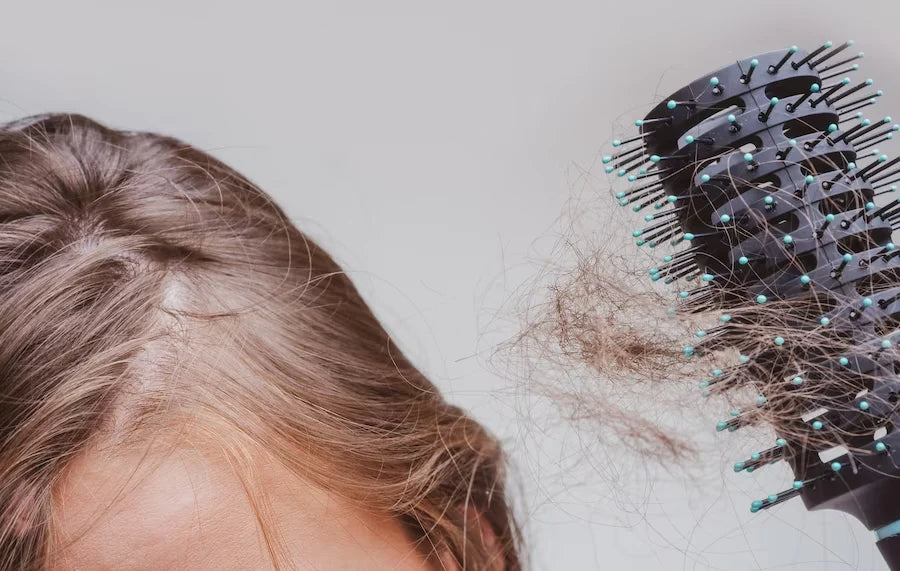October promo: Free supplements with any order! Use code FREESUPPLEMENTS.
You’re not alone: millions share this journey
Hair loss impacts over 50% of men and nearly 40% of women at some point in their lives, often leading to feelings of isolation, anxiety, and loss of confidence. If you’re experiencing hair loss, know that you are not alone—and being here is the first step toward finding hope and solutions.


Pattern baldness
Androgenetic Alopecia (pattern baldness) is the most common cause of hair loss, affecting both men and women. It is primarily driven by genetics and hormones, specifically dihydrotestosterone (DHT), which causes hair follicles to shrink over time. In men, it typically presents as a receding hairline and thinning at the crown, while women often experience diffuse thinning on the top of the scalp.
This condition is so common because it is hereditary, meaning it is passed down through family genes. Hormonal changes and age further contribute to its progression.
While there is no complete cure, treatments can effectively slow down or even reverse hair loss in many cases. Hairgenetix at-home hair mesotherapy changes the game of managing androgenetic alopecia effectively. With micro-needle injections directly into the scalp the Advanced Hair Growth Serum can nourisch the hair follicles directly, ensuring maximum growth stimulation and dormant hair follicle revival.
Hormonal changes
Hormonal changes is another very common cause to hair loss, affecting the hair growth cycle and overall follicle health. More commonly effecting women.
Hormones play a critical role in regulating the hair growth cycle. Shifts in hormone levels, particularly a decrease in estrogen or an increase in dihydrotestosterone (DHT), can disrupt the balance needed for healthy hair growth.
- Menopause: Reduced estrogen levels can cause hair follicles to shrink, leading to thinning hair.
- Postpartum hair loss: After childbirth, a drop in pregnancy hormones can trigger excessive shedding, known as postpartum telogen effluvium.
- Polycystic ovary syndrome (PCOS): Elevated androgens in women with PCOS can lead to hair thinning on the scalp and excess hair growth elsewhere.
- Thyroid disorders: Hypothyroidism or hyperthyroidism can affect hormone levels, resulting in hair loss.




Stress and hair loss
Stress is a common cause of hair loss, primarily triggering a condition called telogen effluvium. In this state, high levels of physical or emotional stress push a significant number of hair follicles into the telogen (resting) phase, leading to noticeable shedding within weeks or months. Prolonged stress can also disrupt hormonal balance, exacerbating conditions like androgenetic alopecia or worsening scalp health.
The good news is that stress-induced hair loss is often temporary and reversible. Managing stress through relaxation techniques, a balanced diet, and adequate rest can help restore the natural hair growth cycle. For persistent issues, Hairgenetix hair growth treatment is a proven solution for repairing stress induced hair damage and restoring hair back to optimal health.
Other common causes
In addition to pattern baldness, hormone changes and stress, as mentioned above, other common causes of hair loss and thinning are:.
- Alopecia areata: An autoimmune condition where the immune system attacks hair follicles, resulting in patchy hair loss.
- Traction alopecia: Hair loss caused by prolonged tension or pulling on hair, often from tight hairstyles.
- Scalp conditions (e.g., psoriasis, seborrheic dermatitis): Inflammation or buildup on the scalp that can hinder hair growth.
- Nutritional deficiencies: Lack of essential nutrients like iron, protein, or biotin that can weaken hair and impede growth.
- Medications or treatments: Certain drugs, such as chemotherapy, can cause hair loss as a side effect.
- Hair damage: Overuse of heat styling tools, harsh chemicals, or excessive bleaching, leading to weakened and brittle hair.
Most of these conditions can be effectively remedied using the proven Hairgenetix hair mesotherapy. Customer results show excellent restoration and reversal of the most common causes of hair loss.








